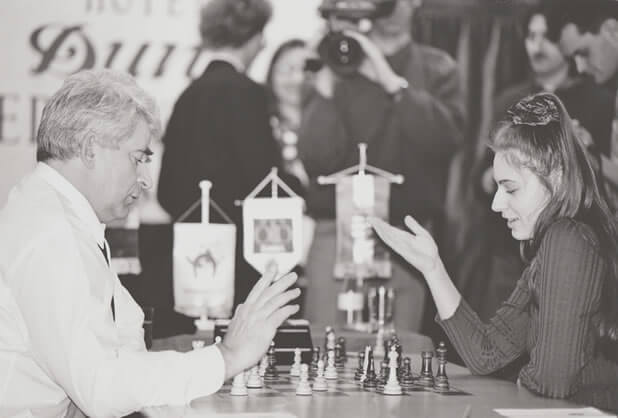- When they were small, Judit and the younger one of her two elder sisters, Sofia, would play with the chess pieces in an alternative way, too. For example, they created "stiletto" shoes with a pair of slippers and two rooks attached to their soles.
- Her mother taught her the chess moves, and her father was her first "coach".
- Judit’s zodiac sign is Leo. At the age of 8, her then coach brought Judit a wood-carved lion as a gift from Kenya. The tiny figurine became Judit's mascot. She took it with her to tournaments and would place it on the table for years.
- At the age of 8-9, she and Zso, the younger of her two elder sisters, used to play blitz games with the adults playing chess on Kulich Gyula Square (in Budapest, now Kalvaria Square) near their apartment – on a one-forint basis (i.e. just a 2 cents). They would spend their winnings on buying fruit at a nearby market.
- My favorite one was a pawn move: white g4, black g5. I surprised my opponent with it in the most unexpected situations, causing quite some headaches to them – and sometimes even to myself...
- At the age of 10, she made it to the front page of The New York Times after finishing first in the New York Open among adult chess players in the unrated section. This was her first international success.
- As a child, she was rather superstitious: no one was allowed to touch the "winning pencil" and the black red and white "winning sweater" with a rook piece, knit by her mother.
- In 1988, a "kid team" represented Hungary at the Chess Olympiad in Thessaloniki: at that time, Susan Polgar and Ildiko Madl were 19, Sofia Polgar 14 and Judit 12. Judit got 12.5 points out of 13 games and the Hungarian team won a gold medal ahead of the Soviet Union. This has been the youngest chess olympics champion team of all times.
- At the age of 12, she spoke for the first time in English at a competition in Hastings, England, recognizing that skipping her mother’s interpretation would leave her more time for the routine pre-game preparations.
- At the competitions, she used to sit cross-legged, Indian style, the benefits of which she discovered at the age of 12, at the Chess Olympiad in Thessaloniki.
- According to a rule within the family, 95% of the time, the competition games between Judit and her two sisters, Susan (female chess world champion between 1996 and 1999) and Sofia (2x female chess olympic champion) ended in a draw.
- Judit's first chess computer was the Soviet Boris (she used to play with it at the age of 5-6), while her favorite one was Kishon Chesster. Thanks to an early chatbot, a built-in speech chip, the latter spoke with the voice of its name-giver, the Hungarian-born Israeli writer and comedian, Ephraim Kishon.
- In 1989, the German Hegener & Glaser named one of the models of their Mephisto chess computer series after the three Polgar Girls (Mephisto Polgar).
- She sat down in merely three women’s tournaments. After the 1990 Chess Olympiad, she only competed in open tournaments, where, except for a few games, she only competed with men.
- She is the first girl in chess history to have won the boy’s junior world championship (U12 in 1988 and U14 in 1990).
- She is the first – and so far the only – woman who made it among the top 10 in the absolute world ranking of chess players (2005).
- She is the first woman to participate in a men’s world championship final (2005).
- She is the first woman to win a medal in the absolute category at the European Championships (2011).


